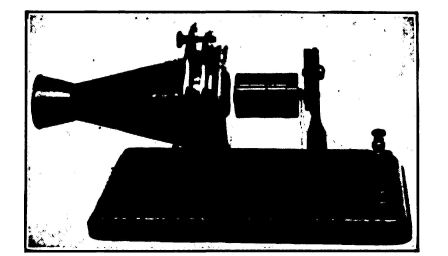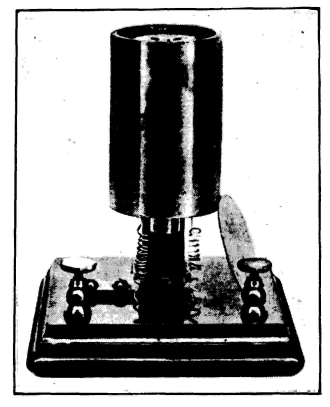| Electrical Communication is a free textbook on the basics of communication technology. See the editorial for more information.... |

|

Home  Early History of Electrical Communication Early History of Electrical Communication  The Early History of the Telephone The Early History of the Telephone |
|||||






|
|||||
The Early History of the TelephoneEarly telephone instruments consisted7 of a coil of wire on a permanent magnet near which was hinged a piece of iron. The iron moved in accordance with the vibrations of a tightly stretched parchment diaphragm. In later sets the hinged piece was not used; instead, the diaphragm had a soft-iron disk attached to its center. As the diaphragm and the attached iron vibrated under the influence of the sound waves, a feeble voltage was induced in the coil, and this voltage caused a current to flow in the distant receiver. Later, an iron diaphragm was substituted for the parchment. The sets exhibited in Philadelphia are shown in Figs. 5 and 6.
At first the public was reluctant to accept the telephone, and it was only after a number of demonstrations that orders were received. These demonstrations often were carried on over the then-existing telegraph lines, one of the longest transmissions being from New York to Boston. The first interconnection of telephone-equipped lines through a switchboard was made in Boston in 1877. These lines belonged to the Holmes Burglar Alarm Company.14 The first commercial switchboard was placed in service in New Haven in 1878, serving eight lines and twenty-one subscribers. As would be expected, there were a number of persons who contended that they, and not Bell, had invented the telephone. Such controversies were carried to the United States Supreme Court, where it was decided that Bell was the inventor of the telephone. The most formidable opponent of Bell and his associates was the Western Union, company which had been operating telegraph lines for a number of years. This organization had both Edison and Gray on its staff. It is of interest to note that Gray had filed a notice that he had an idea upon which he intended to conduct further investigation with the United States Patent Office only a few hours later on the same day that Bell filed his patent application. In 1877, Berliner15 applied for a patent on a transmitter. As Fig. 7 shows, this transmitter consisted essentially of a diaphragm which was free to vibrate under the influence of sound waves, and against which rested a metal ball. When the diaphragm vibrated, the resistance at the contact with the ball was varied but was not broken. In this manner the current from a battery was caused to vary in intensity as the sound waves varied. Edison introduced his transmitter in 1878. This worked on the same principle as Berliner's, but employed contacts consisting of a platinum disk on the diaphragm and a fixed button of carbon. A number of interesting experiments involving loose contacts in transmitters were performed16 by Hughes about 1878. He demonstrated that loose-contact transmitters, or microphones as he called them, were superior to the firmly made contacts of the Edison and Berliner transmitters. It remained for Runnings, however, to make the greatest contribution. He introduced a variable-resistance transmitter consisting (Fig. 8) of a mass of finely divided carbon granules instead of a solid carbon contact. The carbon granules give a large number of points of microphonic contact and are used today in almost all telephone transmitters. During this same period Berliner made an important contribution to telephony by proposing the use of an induction coil with the transmitter (see page 347). Edison was the first to use this principle commercially.
Blake offered to the Bell interests an improved microphonic transmitter consisting of a platinum and a carbon electrode held in contact with springs. This proved successful and was willingly accepted. The AVestern Union Company became convinced that the Bell patents were valid and withdrew from the telephone business.
|
|||||
Home  Early History of Electrical Communication Early History of Electrical Communication  The Early History of the Telephone The Early History of the Telephone |
|||||
Last Update: 2011-05-30



